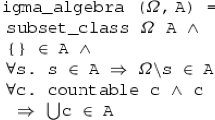Abstract
The main goal of anonymity protocols is to protect the identities of communicating entities in a network communication. An anonymity protocol can be characterized by a noisy channel in the information-theoretic sense. The anonymity of the protocol is then tightly related to how much information is being leaked by the channel. In this paper we investigate a new idea of measuring the information leaked based on how much the rows of the channel probabilities matrix are different from each other. We considered each row of the matrix as a point in the n-dimensional space and we used statistical dispersion measures to estimate how much the points are scattered in the space. Empirical results showed that the two proposed measures KLSD and KLMD are sensitive to the modifications of the attacker capabilities and most importantly they are stable when the a priori distribution on the secret events changes. We show that a variant of KLSD coincides with the classical notion of mutual information which gives the latter an interesting geometric interpretation. The same idea of statistical dispersion is used in a new decision function when the protocol is re-executed several times.
Access this chapter
Tax calculation will be finalised at checkout
Purchases are for personal use only
Preview
Unable to display preview. Download preview PDF.
Similar content being viewed by others
References
Chaum, D.: Untraceable electronic mail, return addresses, and digital pseudonyms. Communications of the ACM 24(2), 84–90 (1981)
Reiter, M., Rubin, A.: Crowds: Anonymity for web transactions. ACM Transactions on Information and System Security 1(1), 66–92 (1998)
Syverson, P., Goldschlag, D., Reed, M.: Anonymous connections and onion routing. In: Proceedings of the 1997 IEEE Symposium on Security and Privacy (SP 1997), Washington, DC, USA. IEEE Computer Society, Los Alamitos (1997)
Chaum, D.: The dining cryptographers problem: unconditional sender and recipient untraceability. Journal of Cryptology 1(1), 65–75 (1988)
Shields, C., Levine, B.: A protocol for anonymous communication over the internet. In: Proceedings of the 7th ACM Conference on Computer and Communications Security, pp. 33–42. ACM, New York (2000)
Serjantov, A., Danezis, G.: Towards an information theoretic metric for anonymity. In: Dingledine, R., Syverson, P.F. (eds.) PET 2002. LNCS, vol. 2482, pp. 41–53. Springer, Heidelberg (2003)
Diaz, C., Seys, S., Claessens, J., Preneel, B.: Towards measuring anonymity. In: Dingledine, R., Syverson, P.F. (eds.) PET 2002. LNCS, vol. 2482, pp. 54–68. Springer, Heidelberg (2003)
Zhu, Y., Bettati, R.: Anonymity vs. information leakage in anonymity systems. In: Proceedings of the 25th IEEE International Conference on Distributed Computing Systems (ICDCS 2005), Columbus, Ohio, pp. 514–524 (2005)
Chatzikokolakis, K., Palamidessi, C., Panangaden, P.: Anonymity protocols as noisy channels. Information and Computation 206(2-4), 378–401 (2008)
Moskowitz, I., Newman, R., Crepeau, D., Miller, A.: Covert channels and anonymizing networks. In: WPES 2003: Proceedings of the 2003 ACM workshop on Privacy in the electronic society, pp. 79–88. ACM, New York (2003)
Cover, T., Thomas, J.: Elements of Information Theory. Wiley-Interscience, New York (1991)
Smith, G.: On the foundations of quantitative information flow. In: de Alfaro, L. (ed.) FOSSACS 2009. LNCS, vol. 5504, pp. 288–302. Springer, Heidelberg (2009)
Rény, A.: On measures of entropy and information. In: Proceedings of the 4th Berkeley Symposium on Mathematics, Statistics, and Probability, pp. 547–561 (1960)
Moskowitz, I., Newman, R., Syverson, P.: Quasi-anonymous channels. In: IASTED CNIS, pp. 126–131 (2003)
Newman, R., Moskowitz, I., Syverson, P., Serjantov, A.: Metrics for traffic analysis prevention. In: Dingledine, R. (ed.) PET 2003. LNCS, vol. 2760, pp. 48–65. Springer, Heidelberg (2003)
Tóth, G., Hornák, Z., Vajda, F.: Measuring anonymity revisited. In: Liimatainen, S., Virtanen, T. (eds.) Proceedings of the Ninth Nordic Workshop on Secure IT Systems, Espoo, Finland, pp. 85–90 (November 2004)
Edman, M., Sivrikaya, F., Yener, B.: A combinatorial approach to measuring anonymity. In: 2007 IEEE Intelligence and Security Informatics, pp. 356–363 (2007)
Chatzikokolakis, K., Palamidessi, C., Panangaden, P.: On the bayes risk in information-hiding protocols. Journal of Computer Security 16(5), 531–571 (2008)
Clark, D., Hunt, S., Malacaria, P.: Quantitative analysis of the leakage of confidential data. Electrical Notes in Theoretical Computer Science 59, 238–251 (2001)
University of Oxford: Prism, http://www.prismmodelchecker.org
Chatzikokolakis, K.: Probabilistic and Information-Theoretic Approaches to Anonymity. PhD thesis, Laboratoire d’Informatique (LIX), École Polytechnique, Paris (October 2007)
MacKay, D.: Information Theory, Inference and Learning Algorithms. Cambridge University Press, Cambridge (2003)
Wright, M., Adler, M., Levine, B., Shields, C.: An analysis of the degradation of anonymous protocols. In: Proceedings of the Network and Distributed Security Symposium (NDSS 2002). IEEE Computer Society, Los Alamitos (2001)
Syverson, P., Tsudik, G., Reed, M., Landwehr, C.: Towards an analysis of onion routing security. In: Proceedings of the international workshop on Designing privacy enhancing technologies, pp. 96–114. Springer, New York (2001)
Gibbs, A., Su, F.: On choosing and bounding probability metrics. International Statistical Institute 70, 418–435 (2002)
Danezis, G., Diaz, C.: A survey of anonymous communication channels. Technical Report MSR-TR-2008-35, Microsoft Research (January 2008)
Dingledine, R., Mathewson, N., Syverson, P.: Tor: the second-generation onion router. In: Proceedings of the 13th Usenix Security Symposium (August 2004)
Author information
Authors and Affiliations
Editor information
Editors and Affiliations
Rights and permissions
Copyright information
© 2010 ICST Institute for Computer Science, Social Informatics and Telecommunications Engineering
About this paper
Cite this paper
Zhioua, S. (2010). A New Information Leakage Measure for Anonymity Protocols. In: Jajodia, S., Zhou, J. (eds) Security and Privacy in Communication Networks. SecureComm 2010. Lecture Notes of the Institute for Computer Sciences, Social Informatics and Telecommunications Engineering, vol 50. Springer, Berlin, Heidelberg. https://doi.org/10.1007/978-3-642-16161-2_23
Download citation
DOI: https://doi.org/10.1007/978-3-642-16161-2_23
Publisher Name: Springer, Berlin, Heidelberg
Print ISBN: 978-3-642-16160-5
Online ISBN: 978-3-642-16161-2
eBook Packages: Computer ScienceComputer Science (R0)




